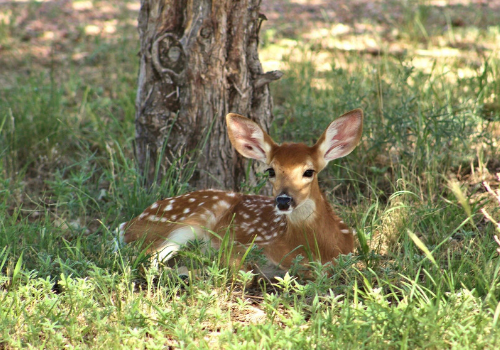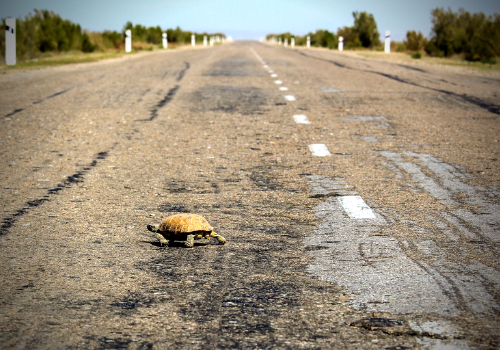It's that time of year... lots and lots of animals are on the move, including their babies! And so are people, which means human/wildlife encounters will be more frequent.
It can be fun to see baby animals, but sometimes they are all alone and you might be worried that they need help! But do they? I visited the Wisconsin DNR website to find out.
Do all animals need help?
Turns out sometimes a baby animal might look like it's alone and in need of help, but many times that is not true. The good intentions of humans can unintentionally cause trouble for animals. As the Wisconsin DNR says: "Remember: A young wild animal's best chance for survival is with its mother!"
Stress from contact with humans, being fed the wrong food, and learning non-natural behavior can all be dangerous for the animal.
But how can we be sure if the animal needs our help or not? The Wisconsin DNR offers this advice for animals they commonly get questions about:
Commonly found baby animals
 |
Fawns
Brand new fawns are not very fast or strong, which is why they have their spotted camouflage coat. They stay still and hidden most of the time while the mother stays away, yet close enough to protect them from predators and she returns to feed her baby every few hours.
What to do: If you find a fawn alone, leave it be, and avoid that spot so you don't give away the location to predators. That way the mother will feel safe enough to return to feed it. If it is truly in danger -- as long as you can do so safely -- you can use clean gloves to pick it up and move it to a safer location close to where it was so the mother can locate it.
 |
Birds
Newly hatched songbirds, called nestlings, do not have feathers and stay in their nest for a couple of weeks, completely dependent on their parents. However, when their feathers begin to develop, they are called fledglings and they leave the nest, hopping on the ground making practice flights and learning to forage for food.
What to do: If you find a nestling, you can place it back in its nest. If the nest has been destroyed, you can make an artificial nest with a clean plastic container filled with a thick layer of dried grass and with drain holes. Secure it as close as possible to the original nest so the parents can find it.
If you find a fledgling, keep cats, dogs, and humans away and watch for the parents to return to check on it. They might just stop briefly to put food in its mouth, but they are taking care of it.
 |
Bunnies
Cottontail nests are shallow and are sometimes in a strange location, like the middle of a yard or in a garden. The mother doesn't stay around the nest in order to avoid attracting predators, but she visits to feed the babies twice a day. They often have multiple litters, so you might find babies from spring through fall.
What to do: If you find a baby cottontail the size of a softball, with eyes open and ears upright, leave it alone as it is old enough to be on its own.
If a nest with younger babies is disturbed by pets, kids, or your own yardwork, rebuild the nest, place the kits back in it and leave it alone until the next morning so the mother will return. Place some grass on top in a crisscross pattern so you can see if the mother has been there. If the grass has been disturbed, continue to avoid the nest to keep it safe from predators.
 |
Turtles
May through July are nesting season for turtles. They lay their eggs on land, usually in a nest they dig themselves. They bury the eggs and leave them to hatch on their own. Baby turtles are completely independent and self-sufficient.
What to do: If you find a turtle on the roadway during nesting season it is likely trying to cross to lay its eggs. If it is safe for yourself and others, you can help the turtle cross, but do not attempt to stop traffic. Keep in mind snapping turtles have long necks and bite hard, so use a shovel or board to scoop it up to carry it or use a stick or long handle to push it across the road in the direction it was traveling. Turning it around will probably mean it will make another attempt to cross because turtles have a home range. Let the turtle go where it wants to go!
What to do if an animal really needs help
If you find an animal that you believe is in real distress, contact a licensed wildlife rehabilitator before assuming it needs help. Five reasons to call a wildlife rehabilitator include:
- The parent is dead or no longer in the area
- The animal has been attacked by a predator, is bleeding or injured
- It appears emaciated, weak, cold, or soaking wet
- The animal is suffering from diarrhea
- It is in a dangerous location
Also remember that some animals are protected under state and federal law, so it may be illegal to remove an animal from the wild or be in possession of it. Check the rules for the specific animal if you need to care for it while you transfer it to a licensed wildlife rehabilitator or veterinarian.
Other ways to help animals
Even though most baby animals don't need our help, there are some things we can do that help all animals, like cleaning up trash, taking great care to eliminate and not to spread invasive species (plants and animals), and being sure to leave no trace of our visits!
Remember, the outside is their home. We are just visitors there!
Laura Miller is the publisher of Macaroni Kid Appleton-Waupaca-Oshkosh, Wis.


